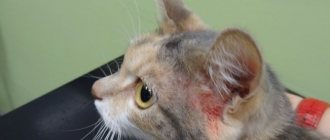One of our readers asked us what it means when a cat keeps scratching its neck. In this case, there is usually an underlying problem that needs to be solved. In this post, we'll look at some of the most common causes of an itchy neck and explain how to solve such problems to give your cat some much-needed relief. First, let's look at the possible answers to this question.
Cats that won't stop scratching their necks usually have parasites, such as fleas or ticks, that need to be addressed. The healing wound may also be itchy and could finally be an allergic reaction to things like house mites or something in your cat's diet.
Causes of itching in the head and neck area in cats
Cats scratch their necks until they hurt for a variety of reasons. This behavior is provoked by external factors, ectoparasites and a number of diseases of varying degrees of danger. The largest number of cases are due to allergies and insect parasites. A smaller percentage of the probability is associated with viral, autoimmune and other diseases.
Ectoparasitosis
Otodectes cynotis, or ear scabies, is caused by mites. They settle in the ears or ear canal and cause severe itching in the cat. As a result, she regularly shakes her head and scratches her ears until they hurt. It is transmitted by contact and affects mainly young animals.
Notoedrosis or pruritic scabies develops against the background of Notoedres cati tick bites. The disease is characterized by inflammation of the scalp, hair loss and severe itching. An infected cat constantly scratches its head until sores appear.
Important! Notoedres cati itches spread from cats to other animals and even humans. For some time they cause pseudo-scabies and then go away, since there are no favorable conditions for life.
Cheyletiellosis, or wandering scabies, is caused by Cheyletiella mites. The fact that a cat has these parasites is indicated by severe itching and fine dandruff. The disease often spreads to humans and causes an itchy rash.
Demodectic mange or ironworm is the result of exposure to mites of the genus Demodex. They develop their vital activity in the sebaceous glands and hair follicles. As a result, bald patches of skin and sores appear on the cats’ faces. The areas most commonly affected are the areas around the eyes and mouth, as well as the front legs.
Fleas are a common cause of scratching on the neck and other parts of the body. They parasitize primarily on cats and dogs. They can also temporarily transfer to humans. When infected with them, a large number of black crumbs appear under the fur of pets. These flea droppings are especially noticeable in the lumbar and back areas.
The animals themselves itch very much to the point of soreness, as they experience severe itching at the bite sites.
Allergies
A common reason why a cat scratches itself until it hurts is allergies. It implies an abnormal reaction of the body to a stimulus. When first hit, protective cells create an antidote and “remember” the allergen. And if it penetrates again, a violent reaction occurs in the body. It leads to inflammation, itching and other symptoms.
Allergies cause several diseases in cats:
- atopic dermatitis;
- flea dermatitis;
- food allergies;
- contact dermatitis.
Flea dermatitis
Flea dermatitis is a common reason why a cat scratches itself until it hurts. When one flea bites, it releases a special anticoagulant into the cat's skin. This substance prevents blood clotting. The pet becomes sensitized to it. And the body reacts to the bites of other fleas in the form of inflammatory processes, rashes and papules.
The affected areas are very itchy. The cat begins to behave restlessly and reacts nervously to touch. This type of dermatitis occurs in two forms: chronic and latent. In the first case, alopecia (foci of baldness) and nodules with flea feces develop on the body. The second is characterized by the appearance of papules with a red rim.
The cat begins to tear them apart until they hurt. Often secondary infection is associated with wounds.
Atopic dermatitis
The disease is typical for young animals aged 1 to 3 years. The main reason for its appearance is the uncontrolled selection of cats. As a result, animals develop allergies to dust and pollen. In this case, it is almost impossible to identify the allergen.
Important! Atopic dermatitis has no cure; cats will regularly scratch their skin until it hurts. The action of therapy is aimed at suppressing symptoms.
Dermatitis in cats manifests itself with the following symptoms:
- the appearance of dandruff on the withers and back;
- hair loss;
- labored breathing;
- discharge from the eyes and nose;
- cough;
- profuse salivation.
Contact dermatitis
This allergy is similar in symptoms to atopic dermatitis. It often manifests itself when the pet comes into contact with household chemicals, toilet filler, the hair of other animals, and flea products. Contact allergies are manifested by severe itching, flaking of the skin and a small rash. Often a cat itches until it hurts. And this increases the risk of secondary infections.
Food allergies
Allergens can accumulate in the body of animals. With their regular consumption, health problems begin. Food allergies are characterized by:
- the appearance of a rash on the cat’s neck and head;
- hair loss;
- the appearance of dandruff;
- inflammation of the eyelids;
- unpleasant odor from the mouth.
Important! Symptoms of food allergies in cats are often accompanied by vomiting and indigestion.
A common cause of food allergies is feeding cats salted, fried, smoked and other prohibited foods from the table. Mixed feeding with industrial feed and natural products also contributes to its appearance.
Fleas
Fleas are one of the most common causes of compulsive scratching and licking. These pesky parasites hide in your cat's fur, potentially evading detection for months—or until an observant owner notices something is wrong. By then, the itching will likely be a major source of grief for your poor kitty.
© shutterstock
Fleas are sneaky bastards; they spend only a small portion of their life cycle on your cat. The rest is spent around the house: on curtains, on the bed or on the rug. They are waiting to return as soon as the flea treatment is finished. This is why it is so important to take extra care and handle all pets and furniture at the same time. If you don't, chances are they'll keep coming back!
- How to check : You know there is a flea infestation when you notice small black dots, which can be seen by closely inspecting the skin. A good flea comb can also be helpful in determining whether your cat needs flea treatment.
- Solution : If you have been unable to prevent fleas, we recommend purchasing a veterinarian certified flea treatment. This will ensure that your treatment contains enough active ingredients. Flea treatments are often sold in tablet or topical form. To get the most benefit from them, you will need to follow the package instructions carefully.
Skin infections
Scratched cat sores on the neck and head in some cases occur due to infectious diseases. Cats with access to the outdoors are especially susceptible to them. When a bacterial infection of the skin occurs, one of two forms develops:
- Dry. Dry crusts, dandruff and scabs form on your cat's neck.
- Wet. It is characterized by the appearance of blisters and ulcers with liquid contents inside.
Animals with sensitive skin are predisposed to eczema. It develops through prolonged contact with flea collars, harnesses, after insect bites and skin parasites.
Important! Diabetes mellitus, neuropathy and hormonal changes contribute to the appearance of eczema.
A rash and blisters appear on the pet's body. Severe itching leads to the cat scratching its neck until it bleeds, and sores appear that do not go away for a long time. To eliminate eczema, antibacterial therapy, various ointments and powders are prescribed.
Viral dermatoses
Cat scratching on the skin is also characteristic of viral dermatoses. The herpes virus affects the eyes and respiratory tract of the animal, often manifesting itself as skin lesions. They are often localized in the area of the nose and eyes, less often on the paws and stomach.
Feline herpes is characterized by:
- bloody stains;
- small rash;
- swelling of the skin;
- small scabs on the neck, sores on the head.
Skin changes appear 1.5 weeks after the disappearance of conjunctivitis and other characteristic symptoms.
Cowpox or poxvirus is a rare disease. It can enter the cat's body through the bites of small rodents. It manifests itself as skin lesions in the form of nodules and small ulcers. With good immunity, it goes away on its own. In weakened animals there is a risk of developing a severe form.
Autoimmune dermatoses
Autoimmune diseases are characterized by an abnormal reaction of the immune system to its own tissues and cells. Skin manifestations on the body of cats are characteristic of several diseases:
- Common pemphigus. It is characterized by the development of ulcers in cats around the mouth and in its cavity itself. Involves long and difficult treatment. It often ends critically for animals.
- Erythematous pemphigus. Crusts, ulcers, blisters, sores and other lesions are concentrated in the area of the animal’s nose and bridge of the nose. Sometimes the disease is accompanied by a change in skin color.
- Pemphigus foliaceus. The main symptom is the appearance of large pustules on the skin near the mouth and ears. Associated signs in cats include elevated body temperature, refusal to eat, and apathy.
- Systemic lupus erythematosus. It affects all systems and organs of the animal. Wounds on the scalp manifest themselves through depigmentation of the skin, the development of a rash and the subsequent formation of ulcers.
Effective Treatments
Itching and scratchy wounds are a consequence of the disease. Until the cause is eliminated, it is impossible to relieve the itching. But before the animal gets to the veterinarian, its condition can be alleviated. To do this, wounds need to be disinfected with hydrogen peroxide, Chlorhexidine or Miramistin. You cannot use any cosmetics, such as shampoo, cream, wool powder.
To prevent the cat from licking the medicine from the fur, you should wear a special collar.
A special collar protects the animal.
Treatment methods are selected individually based on test results:
| Type of disease | Treatment |
| Demodicosis | Lasts up to a year. It involves a number of measures:
|
| Helminthiasis | Antihelminthic drugs are prescribed (Febtal, Panacur, Prazitel, Kanikvantel). |
| Bacterial infection | Prescribed:
|
| Eczema | Therapy should be comprehensive:
|
| Allergy | Necessary:
|
| Dermatomycoses | Therapy lasts up to 2 months and involves:
|
For treatment to be effective, you need to provide your cat with a balanced diet. Nutrition should be adjusted, even if the cause of the pathology is not a food allergy. A lack of vitamins and microelements negatively affects the condition of the skin and coat, and the speed of wound healing.
Skin tumors
Skin neoplasms are in first place among oncological diseases in animals. By their nature, they are also divided into benign and malignant forms.
The first includes:
- Basalioma. The sore is a pigmented dome-shaped tumor. At the point where it appears, the animal loses its hair.
- Cutaneous histiocytoma. Characterized by a rapidly growing tumor under the skin. A rare pathology for cats.
Malignant skin tumors develop in two cases:
- Squamous cell carcinoma. The disease manifests itself in the nose, eyelids and ears. Metastases spread through the lymphatic system.
- Basal cell carcinoma. Develops from basal cells of the skin. Characterized by rapid growth and a high probability of metastasis.
Veterinarian advice
It is not recommended to curtail your pet’s freedom and lock it within four walls in an attempt to protect it from illnesses. Infection is possible through the owner's shoes and hands, even if the cat is domestic.
Veterinarians give some recommendations for caring for furry purrs:
- Keep your pet clean.
- Provide a balanced diet.
- Do not give your cat smoked meats, salty foods and sweets.
- Protect the animal from stress and pay attention to it.
Keeping your pet clean Balanced diet Attention from the owner
The cat licks and itches, but there are no fleas
In addition to the presence of fleas, increased attention to fur may be caused by the following reasons:
- allergic reaction;
- fungal infection;
- changes in hormone levels;
- excess or lack of vitamins in the body;
- changes in diet.
The cat licks itself vigorously and goes bald
Itching may have a psychological cause. For example, a pet experiences stress if it does not have the opportunity to mate. The cat can be calmed using a sedative.
Cat licks after sterilization
After surgery, a stitch remains on the pet’s abdomen, which can pull and itch. To avoid injury to the suture, put a collar on the cat until the wound heals.
What to do if your cat is constantly licking
It is difficult to independently identify the cause of your pet’s behavior. He should be examined for fleas, lichen spots, and wounds. It is important to analyze your recent lifestyle, changes in diet and hair products. You need to tell your veterinarian about all changes, this will help with diagnosis.
If your cat is constantly licking you need to take her to the vet.
History taking
Diagnostics will help you understand why your cat scratches its neck and what caused the sores. But before carrying it out, the veterinarian needs to collect an anamnesis.
Age and breed
A kitten up to one year old is susceptible to skin and subcutaneous parasites. Young animals suffer predominantly from allergic reactions. If an elderly cat scratches its neck until it bleeds and hurts, this may be due to autoimmune dermatoses.
The breed of the animal also leaves its mark. Persian cats are prone to dermatophytosis and dermatitis, while Sphynx cats are prone to allergies and neoplasms.
Lifestyle
A large number of animals in one area, access to the street, participation in cat shows and other factors increase the risk of infection with parasites and viral diseases.
Seasonality
Allergies to pollen, bee or mosquito bites have a pronounced seasonality. Flea dermatitis in cats manifests itself regardless of the time of year. But it is most common in August-September.
Features of the reaction
Signs of different types of allergies have similar manifestations. A pathological reaction to flea saliva can cause extensive damage to the croup, back and tail. Food allergies most often occur in the head and neck area. Periods of seasonal exacerbation are also possible. The phenomenon is most typical for atopic dermatitis.
It is important to find out in a timely manner why your cat scratches its neck a lot. Ulcers, open wounds and rashes can pose a serious threat to the health and life of a pet, acting as a source of secondary infection. Some members of the cat family are more prone to allergic reactions.
This fact is explained by heredity and the characteristics of the breed. Pronounced signs can manifest themselves against the background of insufficiency of the enzymatic system, congenital pathologies of the gastrointestinal tract, and unfavorable ecology of the habitat.
Diagnostic methods
Diagnostics will help determine why a cat scratches its neck until it hurts. The doctor prescribes one or more methods:
- Combing wool. A fine comb is used for this. The procedure allows you to see fleas, lice and skin mites on cats. Can be done independently at home.
- Trichogramma. Determines the presence of spores and eggs on the hair shaft.
- Examination of earwax under a microscope. It is carried out if otodectosis is suspected.
- Wood's lamp. Shows the glow of spores on the skin of an animal from certain types of fungus.
- Cytological examination. The veterinarian recommends this to detect yeast and bacterial infections.
- Allergy test. Prescribed for confirmed atopic allergies in cats.
- Skin scraping. Detects ticks, their larvae, and spores.
- Elimination diet. Prescribed by a veterinarian to determine the allergen for food allergies.
- Fungal culture. An effective method for dermatophytes.
Signs of a pathological condition of an animal
Cats regularly look after their fur, licking themselves, scratching, and biting. But as the disease progresses, the pet’s behavior changes. If the following symptoms occur, you need to examine the animal and contact a veterinary clinic:
- Frequent scratching, the cat biting its fur and meowing pitifully.
- Constant biting of skin.
- Formation of bald patches, deterioration in the appearance of the coat.
- The appearance of dandruff and oily scales on the neck.
- The appearance of ulcers, red rashes, and spots on the neck.
- Detection of parasites and/or their metabolic products on the pet’s skin.
Frequent scratching of the neck is an alarming symptom
Prevention
Both purebred cats (British, Scottish Fold, Maine Coon) and outbred pets are susceptible to sores and scratches due to itching around the ears, on the stomach and back, and limbs. To protect your pet from skin diseases, you should protect your cat from contact with sick animals and carry out regular treatment with flea and anthelmintic agents. Cosmetics for care and food should be chosen of high quality, with natural additives. Purchase industrial food products that are hypoallergenic. Carry out hygienic cleaning of ears and eyes with special means. It is recommended to periodically disinfect the sleeping area.
What the owner should do if the cat is itching
The cat began to itch - what should the owner do? If Murka is constantly itching and licking, then the reason should be established as soon as possible. Otherwise, scratches appear on the skin, and the skin itself no longer protects. The risks of developing fungal infections and bacterial ulcers are increasing due to secondary damage to the skin by various pathogens. Considering the number of all possible causes, it is pointless to find out on your own. The maximum that the owner is conditionally allowed to do is treat the cat for ticks and fleas, if this has not been done for a long time.
Self-prescription of antihistamines is also not acceptable! Firstly, not everything that itches is an allergy, and secondly, the mechanism of action of this group of drugs differs from person to person, so they may simply not work. Often in such cases, owners think that they have given a small dosage and increase it, resulting in the cat being poisoned with medications.
Eczema
Eczema affects the top layer of skin, causing redness, a rash, and then oozing blisters. All this causes itching in animals and scratching of inflamed skin. In the event of a bacterial infection, sores appear on areas of the skin affected by eczema - flaky and filled with pus.
In dogs, eczema most often affects the lumbar region, but gradually affects larger areas of the skin. If the process involves deeper layers of skin, then we will talk about dermatitis.
There are many causes of eczema: these are both external and internal factors. Eczema can be caused by diseases of internal organs and endocrine disorders. Therefore, it is so important that a correct diagnosis is made and adequate treatment is prescribed.
After all, no ointments can rid your pet of this insidious disease until you normalize the functioning of its internal organs.
Why you can't stop itching
If you have not yet visited the veterinarian, you should not smear the sores with anything at all - this will distort the results of scrapings and tests, which will complicate the diagnosis. You should not immediately offer your animal antihistamines - firstly, you may not guess the dosage, and secondly, the blood test will be invalid.
Once the veterinarian has prescribed medications and ointments, there is no need to relieve itching - most medications already contain substances that reduce discomfort.
Finally, anti-itch medications in humans can cause allergies in cats, which will only make the problem worse.










